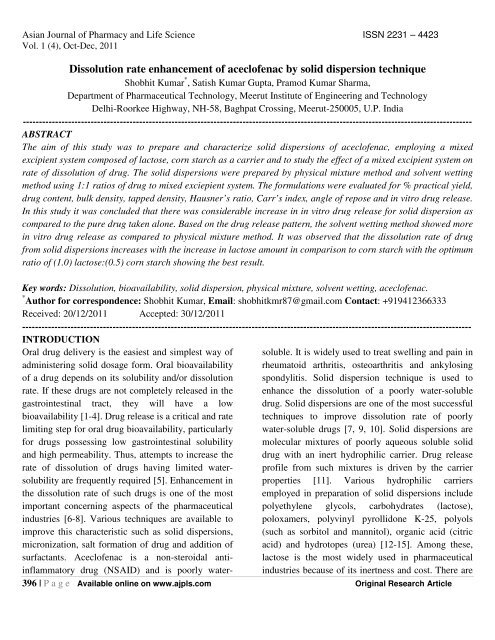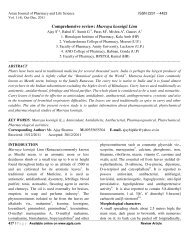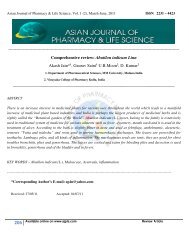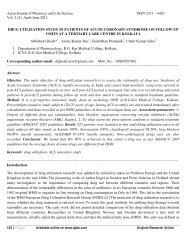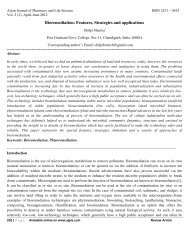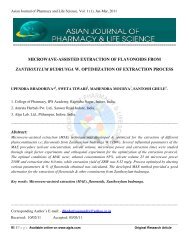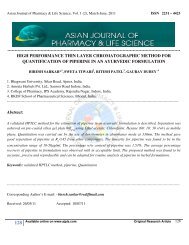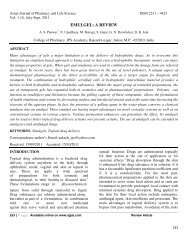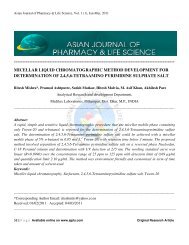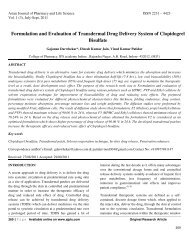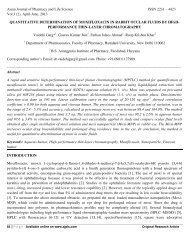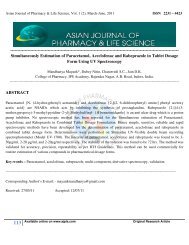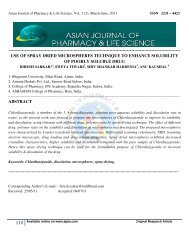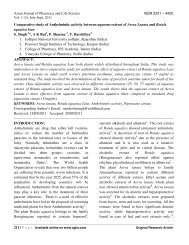Dissolution rate enhancement of aceclofenac by solid dispersion ...
Dissolution rate enhancement of aceclofenac by solid dispersion ...
Dissolution rate enhancement of aceclofenac by solid dispersion ...
You also want an ePaper? Increase the reach of your titles
YUMPU automatically turns print PDFs into web optimized ePapers that Google loves.
Asian Journal <strong>of</strong> Pharmacy and Life Science ISSN 2231 – 4423<br />
Vol. 1 (4), Oct-Dec, 2011<br />
<strong>Dissolution</strong> <strong>rate</strong> <strong>enhancement</strong> <strong>of</strong> acecl<strong>of</strong>enac <strong>by</strong> <strong>solid</strong> <strong>dispersion</strong> technique<br />
Shobhit Kumar * , Satish Kumar Gupta, Pramod Kumar Sharma,<br />
Department <strong>of</strong> Pharmaceutical Technology, Meerut Institute <strong>of</strong> Engineering and Technology<br />
Delhi-Roorkee Highway, NH-58, Baghpat Crossing, Meerut-250005, U.P. India<br />
-------------------------------------------------------------------------------------------------------------------------------------------<br />
ABSTRACT<br />
The aim <strong>of</strong> this study was to prepare and characterize <strong>solid</strong> <strong>dispersion</strong>s <strong>of</strong> acecl<strong>of</strong>enac, employing a mixed<br />
excipient system composed <strong>of</strong> lactose, corn starch as a carrier and to study the effect <strong>of</strong> a mixed excipient system on<br />
<strong>rate</strong> <strong>of</strong> dissolution <strong>of</strong> drug. The <strong>solid</strong> <strong>dispersion</strong>s were prepared <strong>by</strong> physical mixture method and solvent wetting<br />
method using 1:1 ratios <strong>of</strong> drug to mixed exciepient system. The formulations were evaluated for % practical yield,<br />
drug content, bulk density, tapped density, Hausner’s ratio, Carr’s index, angle <strong>of</strong> repose and in vitro drug release.<br />
In this study it was concluded that there was considerable increase in in vitro drug release for <strong>solid</strong> <strong>dispersion</strong> as<br />
compared to the pure drug taken alone. Based on the drug release pattern, the solvent wetting method showed more<br />
in vitro drug release as compared to physical mixture method. It was observed that the dissolution <strong>rate</strong> <strong>of</strong> drug<br />
from <strong>solid</strong> <strong>dispersion</strong>s increases with the increase in lactose amount in comparison to corn starch with the optimum<br />
ratio <strong>of</strong> (1.0) lactose:(0.5) corn starch showing the best result.<br />
Key words: <strong>Dissolution</strong>, bioavailability, <strong>solid</strong> <strong>dispersion</strong>, physical mixture, solvent wetting, acecl<strong>of</strong>enac.<br />
* Author for correspondence: Shobhit Kumar, Email: shobhitkmr87@gmail.com Contact: +919412366333<br />
Received: 20/12/2011 Accepted: 30/12/2011<br />
-------------------------------------------------------------------------------------------------------------------------------------------<br />
INTRODUCTION<br />
Oral drug delivery is the easiest and simplest way <strong>of</strong> soluble. It is widely used to treat swelling and pain in<br />
administering <strong>solid</strong> dosage form. Oral bioavailability rheumatoid arthritis, osteoarthritis and ankylosing<br />
<strong>of</strong> a drug depends on its solubility and/or dissolution spondylitis. Solid <strong>dispersion</strong> technique is used to<br />
<strong>rate</strong>. If these drugs are not completely released in the enhance the dissolution <strong>of</strong> a poorly water-soluble<br />
gastrointestinal tract, they will have a low drug. Solid <strong>dispersion</strong>s are one <strong>of</strong> the most successful<br />
bioavailability [1-4]. Drug release is a critical and <strong>rate</strong> techniques to improve dissolution <strong>rate</strong> <strong>of</strong> poorly<br />
limiting step for oral drug bioavailability, particularly water-soluble drugs [7, 9, 10]. Solid <strong>dispersion</strong>s are<br />
for drugs possessing low gastrointestinal solubility molecular mixtures <strong>of</strong> poorly aqueous soluble <strong>solid</strong><br />
and high permeability. Thus, attempts to increase the drug with an inert hydrophilic carrier. Drug release<br />
<strong>rate</strong> <strong>of</strong> dissolution <strong>of</strong> drugs having limited watersolubility<br />
pr<strong>of</strong>ile from such mixtures is driven <strong>by</strong> the carrier<br />
are frequently required [5]. Enhancement in properties [11]. Various hydrophilic carriers<br />
the dissolution <strong>rate</strong> <strong>of</strong> such drugs is one <strong>of</strong> the most employed in preparation <strong>of</strong> <strong>solid</strong> <strong>dispersion</strong>s include<br />
important concerning aspects <strong>of</strong> the pharmaceutical polyethylene glycols, carbohyd<strong>rate</strong>s (lactose),<br />
industries [6-8]. Various techniques are available to poloxamers, polyvinyl pyrollidone K-25, polyols<br />
improve this characteristic such as <strong>solid</strong> <strong>dispersion</strong>s, (such as sorbitol and mannitol), organic acid (citric<br />
micronization, salt formation <strong>of</strong> drug and addition <strong>of</strong> acid) and hydrotopes (urea) [12-15]. Among these,<br />
surfactants. Acecl<strong>of</strong>enac is a non-steroidal antiinflammatory<br />
lactose is the most widely used in pharmaceutical<br />
drug (NSAID) and is poorly water-<br />
industries because <strong>of</strong> its inertness and cost. There are<br />
396 | P a g e Available online on www.ajpls.com Original Research Article
Asian Journal <strong>of</strong> Pharmacy and Life Science ISSN 2231 – 4423<br />
Vol. 1 (4), Oct-Dec, 2011<br />
various methods for preparing <strong>solid</strong> <strong>dispersion</strong> which<br />
includes solvent wetting method, physical mixture,<br />
solvent evaporation method, melting method, solvent<br />
wetting method, fusion method, kneading method and<br />
super critical fluid method, etc [16- 19].<br />
MATERIALS AND METHODS<br />
Materials<br />
Acecl<strong>of</strong>enac was <strong>of</strong> pharmaceutical grade sample,<br />
gifted from Cipla Ltd, Mumbai, India. Lactose and<br />
corn starch were purchased from SD Fine Chemicals<br />
Ltd, Mumbai, India. All solvents were <strong>of</strong> analytical<br />
grade and were used without further purification.<br />
Methods<br />
Preparation <strong>of</strong> <strong>solid</strong> <strong>dispersion</strong>s<br />
a) Preparation <strong>by</strong> physical mixture method<br />
The ratio <strong>of</strong> drug: mixed excipient system was kept<br />
constant (1:1 w/w) in all formulations. Physical<br />
mixtures <strong>of</strong> acecl<strong>of</strong>enac with mixed excipient system<br />
including lactose and corn starch were prepared <strong>by</strong><br />
mixing accu<strong>rate</strong>ly the weighed amount <strong>of</strong> drug and<br />
carrier with the help <strong>of</strong> a spatula in a glass mortar.<br />
b) Preparation <strong>by</strong> solvent wetting method<br />
The required amount <strong>of</strong> acecl<strong>of</strong>enac was dissolved in<br />
an appropriate amount <strong>of</strong> isopropyl alcohol. This<br />
solution was dropped onto mixed excipient system<br />
placed in mortar and was constantly stirred. Finally<br />
the solvent was removed <strong>by</strong> evaporation at room<br />
temperature. The powder so obtained was ground in a<br />
mortar and stored in desiccators.<br />
Various ratios <strong>of</strong> lactose and corn starch used for<br />
preparation <strong>of</strong> <strong>solid</strong> <strong>dispersion</strong><br />
Physical mixture method<br />
1:0.5 ratio <strong>of</strong> lactose and corn starch (F1)<br />
0.5:1 ratio <strong>of</strong> lactose and corn starch (F2)<br />
1:1 ratio <strong>of</strong> lactose and corn starch (F3)<br />
Solvent wetting method<br />
1:0.5 ratio <strong>of</strong> lactose and corn starch (F4)<br />
0.5:1 ratio <strong>of</strong> lactose and corn starch (F5)<br />
1:1 ratio <strong>of</strong> lactose and corn starch (F6)<br />
EVALUATION PARAMETERS<br />
Determination <strong>of</strong> % practical yield<br />
Determination <strong>of</strong> practical yield is useful to determine<br />
the efficiency <strong>of</strong> a preparation technique. The<br />
practical yield is calculated <strong>by</strong> using following<br />
equation:<br />
% Practical yield (%) =<br />
(Weight <strong>of</strong> prepared <strong>solid</strong> <strong>dispersion</strong>s × 100)<br />
Theoretical weight<br />
Estimation <strong>of</strong> drug content<br />
Dissolve <strong>solid</strong> <strong>dispersion</strong>s (equivalent to 100 mg <strong>of</strong><br />
drug) in 100 ml <strong>of</strong> methanol. The solution was<br />
filtered, diluted suitably and analyzed at 275 nm <strong>by</strong><br />
employing UV spectrophotometer. The drug content<br />
is calculated <strong>by</strong> following formula:<br />
Percent drug content =<br />
(Acecl<strong>of</strong>enac amount in weighed quantity <strong>of</strong> <strong>solid</strong> <strong>dispersion</strong>s x 100)<br />
Theoretical amount <strong>of</strong> drug in <strong>solid</strong> <strong>dispersion</strong><br />
PHYSICAL CHARACTERIZATION OF SOLID<br />
DISPERSIONS<br />
Micromeritic study<br />
Determination <strong>of</strong> apparent bulk density:<br />
The powder blend was weighed first and then placed<br />
in a graduated cylinder and measure the volume <strong>of</strong> it.<br />
This gives the relationship to find out the apparent<br />
bulk density (g/ml).<br />
Apparent bulk density = Weight <strong>of</strong> powder blend<br />
Volume <strong>of</strong> powder blend<br />
Determination <strong>of</strong> tapped density:<br />
Tapped density was measured for each batch using<br />
Tap Density Tester (USP) (Electro lab Etd-1020). The<br />
pre-weighed amount <strong>of</strong> powder blend was placed in a<br />
graduated cylinder and tapped for fixed number <strong>of</strong><br />
taps (around 100) on mechanical tapping apparatus.<br />
397 | P a g e Available online on www.ajpls.com Original Research Article
Asian Journal <strong>of</strong> Pharmacy and Life Science ISSN 2231 – 4423<br />
Vol. 1 (4), Oct-Dec, 2011<br />
From this the tapped volume was noted. Finally the<br />
tapped density was computed using the formula:<br />
Tapped density = Weight <strong>of</strong> powder blend<br />
Tapped volume <strong>of</strong> powder blend<br />
Determination <strong>of</strong> Carr’s index: It was used to<br />
determine the % compressibility <strong>of</strong> powder blends. It<br />
was calculated <strong>by</strong> using the value <strong>of</strong> tapped density<br />
and bulk density.<br />
Carr’s index = (Tapped density - Apparent bulk density)<br />
Tapped density<br />
Determination <strong>of</strong> angle <strong>of</strong> repose: It was determined<br />
<strong>by</strong> using funnel method. A funnel with its tip at a<br />
given height (H), above a piece <strong>of</strong> graph paper was<br />
fixed on a plane surface. Powder blend was poured<br />
through the funnel such that the apex <strong>of</strong> the conical<br />
pile touched the tip <strong>of</strong> the funnel. The angle <strong>of</strong> repose<br />
(θ) was then calculated as follows:<br />
tan θ = H<br />
R<br />
where, R is the radius <strong>of</strong> the conical pile.<br />
<strong>Dissolution</strong> studies<br />
In vitro release pr<strong>of</strong>iles for each batch was performed<br />
using USP dissolution apparatus (Electro lab TDL-<br />
8L, Mumbai, India). Pure drug and <strong>solid</strong> <strong>dispersion</strong>s<br />
<strong>of</strong> drug (prepared <strong>by</strong> both the techniques) were kept<br />
in the baskets <strong>of</strong> dissolution apparatus. The<br />
dissolution testing was carried out at a temperature 37<br />
± 0.5° C and a sterring <strong>rate</strong> <strong>of</strong> 50 rpm in 900 ml <strong>of</strong> 1.2<br />
pH <strong>of</strong> HCl solution. Aliquot <strong>of</strong> 5 ml were withdrawn<br />
every ten minutes upto 90 minutes. The same amount<br />
<strong>of</strong> withdrawn volume was replaced with the<br />
dissolution medium in order to maintain the sink<br />
condition. Acecl<strong>of</strong>enac concentration was determined<br />
spectrophotometrically at 275 nm.<br />
RESULTS AND DISCUSSION<br />
Solid <strong>dispersion</strong>s <strong>of</strong> acecl<strong>of</strong>enac were prepared with<br />
mixed excipient system using physical mixture<br />
method as well as solvent wetting method. Drug<br />
content in all prepared batches was determined, which<br />
were fairly within the limits. Percentage yield and<br />
percent drug content <strong>of</strong> all formulations formed were<br />
determined. It was found that percent drug content<br />
and percent practical yield were found to be 99.00%<br />
and 99.64% respectively in case <strong>of</strong> F4 formulation<br />
and 99.01% and 99.22% in case <strong>of</strong> F1 formulation.<br />
The data illust<strong>rate</strong>s the fact that, formulation, F4 and<br />
F1 releases more drugs in comparison to other<br />
formulations during same time interval. The result<br />
studies <strong>of</strong> various parameters are shown in table 1.<br />
Findings <strong>of</strong> study reveal the fact that granules<br />
prepared <strong>by</strong> both method posses better flow<br />
behaviour. Granules were having bulk density and<br />
tapped density within good range; hence their<br />
compression is easily done. This factor is thus <strong>of</strong><br />
greatest importance while studying the physical<br />
parameters. The dissolution behaviour showed that<br />
formulations prepared <strong>by</strong> solvent wetting method has<br />
better release characteristics as compared to the<br />
formulations prepared <strong>by</strong> physical mixture method.<br />
Acecl<strong>of</strong>enac and (1.0) lactose:(0.5) corn starch <strong>solid</strong><br />
<strong>dispersion</strong> (F4) prepared <strong>by</strong> solvent wetting method<br />
showed the greatest drug release pr<strong>of</strong>ile than all other<br />
formulations. The release data is shown in following<br />
fig 1. Thus the experiment showed that lactose and<br />
solvent wetting method can be used to improve the<br />
dissolution characteristics <strong>of</strong> poorly water-soluble<br />
drug in pharmaceutical formulations.<br />
CONCLUSION<br />
The major problem <strong>of</strong> acecl<strong>of</strong>enac is its very poor<br />
solubility in biological fluids. From the present study<br />
it can be easily demonst<strong>rate</strong>d that lactose has<br />
immense potential to improve dissolution characters<br />
<strong>of</strong> any less soluble or poorly water-soluble drug. The<br />
results revealed that it is possible to enhance the<br />
dissolution <strong>rate</strong> <strong>of</strong> acecl<strong>of</strong>enac <strong>by</strong> increasing the<br />
surface area <strong>of</strong> the drug <strong>by</strong> <strong>solid</strong> <strong>dispersion</strong> method.<br />
Formulation prepared <strong>by</strong> solvent wetting method<br />
using acecl<strong>of</strong>enac and (1.0) lactose:(0.5) corn starch<br />
398 | P a g e Available online on www.ajpls.com Original Research Article
Asian Journal <strong>of</strong> Pharmacy and Life Science ISSN 2231 – 4423<br />
Vol. 1 (4), Oct-Dec, 2011<br />
<strong>of</strong> ratio 1:1 (F4) yielded best results in terms <strong>of</strong><br />
dissolution <strong>rate</strong>. This work also illust<strong>rate</strong>s the fact that<br />
lactose has more characteristic to form <strong>solid</strong><br />
<strong>dispersion</strong>s with the drug molecules, there<strong>by</strong><br />
increasing the dissolution <strong>rate</strong> <strong>of</strong> drug and decreasing<br />
the time <strong>of</strong> release <strong>of</strong> drug from the formulated<br />
mixture.<br />
Fig 1: In-vitro drug release pr<strong>of</strong>ile <strong>of</strong> acecl<strong>of</strong>enac in HCl solution (pH 1.2) from <strong>solid</strong> <strong>dispersion</strong><br />
Table 1: Evaluation parameters for <strong>solid</strong> <strong>dispersion</strong>s<br />
Evaluation parameters F1 F2 F3 F4 F5 F6<br />
% practical yield 99.22 99.61 99.70 99.64 99.35 99.67<br />
Bulk density (gm/cm) 0.75 0.73 0.75 0.73 0.70 0.69<br />
Tapped density (gm/cm) 0.81 0.80 0.82 0.82 0.77 0.77<br />
Carr’s index (%) 7.40 8.75 8.53 10.97 9.09 10.38<br />
Hausner’ ratio 1.08 1.09 1.09 1.03 1.05 1.11<br />
Drug content (%) 99.01 99.11 98.43 99.00 99.21 99.03<br />
Angle <strong>of</strong> repose (Degree) 24.07 23.22 22.76 15.32 12.05 11.89<br />
REFERENCES<br />
1. Kumar S., Malviya R., Sharma P.K., Solid<br />
Dispersion: Pharmaceutical Technology for<br />
the Improvement <strong>of</strong> Various Physical<br />
Characteristics <strong>of</strong> Active Pharmaceutical<br />
Ingredient. Afr. J. Basic. Appl. Sci. 2011; 3:<br />
116-125.<br />
2. Waghmare A., Pore Y., Kuchekar B.,<br />
Development and characterization <strong>of</strong> zaleplon<br />
<strong>solid</strong> <strong>dispersion</strong> systems: Atechnical note.<br />
AAPS PharmSciTech. 2008; 9: 536-543.<br />
3. Streubel A., Siepmann J., Bodmeier R., Drug<br />
delivery to the upper small intestine window<br />
using gastroretentive technologies. Curr.<br />
Opin. Pharmacol. 2006; 6: 501-508.<br />
399 | P a g e Available online on www.ajpls.com Original Research Article
Asian Journal <strong>of</strong> Pharmacy and Life Science ISSN 2231 – 4423<br />
Vol. 1 (4), Oct-Dec, 2011<br />
4. Sugawara M., Kadomura S., He X., Takekuma<br />
Y., Kohri N., Miyazaki K., The use <strong>of</strong> an<br />
invitro dissolution and absorption system to<br />
evaluate oral absorption <strong>of</strong> two weak bases in<br />
pH-dependent controlled-release formulations.<br />
Eur. J. Pharm. Sci. 2005; 26: 1-8.<br />
5. Desai J., Alexander K., Riga A.,<br />
Characterization <strong>of</strong> polymeric <strong>dispersion</strong>s <strong>of</strong><br />
dimenhydrinate in ethylcellulose for<br />
controlled release. Int J. Pharm. 2006; 308:<br />
115-123.<br />
6. Vippagunta S.R., Wang Z., Hornung S., Krill<br />
S.L., Factors affecting the formation <strong>of</strong><br />
eutectic <strong>solid</strong> <strong>dispersion</strong>s and their dissolution<br />
behaviour. J. Pharm. Sci. 2006; 96: 294-304.<br />
7. Shahroodi A.B., Nassab P.R., Revesz P.S.,<br />
Preparation <strong>of</strong> a <strong>solid</strong> <strong>dispersion</strong> <strong>by</strong> a<br />
dropping method to improve the <strong>rate</strong> <strong>of</strong><br />
dissolution <strong>of</strong> meloxicam. Drug. Dev. Ind.<br />
Pharm. 2008; 34: 781-788.<br />
8. Leuner C., Dressnan J., Improving drug<br />
solubility for oral delivery using <strong>solid</strong><br />
<strong>dispersion</strong>s. Eur. J. Pharm. Biopharm. 2000;<br />
50: 47-60.<br />
9. Streubel A., Siepmann J., Bodmeier R., Drug<br />
delivery to the upper small intestine window<br />
using gastroretentive technologies. Curr.<br />
Opin. Pharmacol. 2006; 6: 501-508.<br />
10. Konno H., Handa T., Alonzo D.E., Taylor<br />
L.S., Effect <strong>of</strong> polymer type on the dissolution<br />
pr<strong>of</strong>ile <strong>of</strong> amorphous <strong>solid</strong> <strong>dispersion</strong><br />
containing felodipine. Eur. J. Pharm.<br />
Biopharm. 2008; 70: 493-499.<br />
11. Vasconcelos T.F., Sarmento B., Costa P.,<br />
Solid <strong>dispersion</strong>s as st<strong>rate</strong>gy to improve oral<br />
bioavailability <strong>of</strong> poor water soluble drugs.<br />
Drug Discov. Today. 2007; 12: 1068-1075.<br />
12. Ahuja N., Katare O.M., Singh B., Studies on<br />
dissolution <strong>enhancement</strong> and mathematical<br />
modeling <strong>of</strong> drug release <strong>of</strong> a poorly watersoluble<br />
drug using water-soluble carriers. Eur.<br />
J. Pharm. Biopharm. 2007; 65: 26-38.<br />
13. Mahaparale P.R., Gudsoorkar V.R., Gajeli<br />
G.B., Kuchekar B.S., Studies on <strong>solid</strong><br />
<strong>dispersion</strong>s <strong>of</strong> meloxicam. Ind. J. Pharm.<br />
Educ. Res. 2006; 40: 241-244.<br />
14. Zerrouk N., Mennini N., Maestrelli F.,<br />
Chemtob C., Mura P., Comparison <strong>of</strong> the<br />
effect <strong>of</strong> chitosan and polyvinyl pyrrolidone<br />
on dissolution properties and analgesic effect<br />
<strong>of</strong> naproxen. Eur. J. Pharm. Biopharm. 2004;<br />
57: 93-99.<br />
15. Bhise S.B., Rajkumar M., Effect <strong>of</strong> HPMC on<br />
solubility and dissolution <strong>of</strong> carbamazepine<br />
form III in simulated gastrointestinal fluids.<br />
Asian. J. Pharm. 2008; 2: 38-42.<br />
16. Laitinen R. Suihko E., Toukola K., Björkqvist<br />
M., Riikonen J., Lehto V.P., Jarvinen K.,<br />
Ketolainen J., Intra orally fast-dissolving<br />
particles <strong>of</strong> a poorly soluble drug: Preparation<br />
and invitro characterization. Eur. J. Pharm.<br />
Biopharm. 2009; 71: 271-281.<br />
17. Kim E.J., Chun M.K., Jang J.S., Lee I.H., Lee<br />
K.R., Choi H.K., Preparation <strong>of</strong> a <strong>solid</strong><br />
<strong>dispersion</strong> <strong>of</strong> felodipine using a solvent<br />
wetting method. Eur. J. Pharm. Biopharm.<br />
2006; 64: 200-205.<br />
18. Urbanetz N.A., Lippold B.C., Solid<br />
<strong>dispersion</strong>s <strong>of</strong> nimodipine and polyethylene<br />
glycol 2000: dissolution properties and<br />
physic-chemical characterisation. Eur. J.<br />
Pharm. Biopharm. 2005; 59: 107-118.<br />
400 | P a g e Available online on www.ajpls.com Original Research Article


